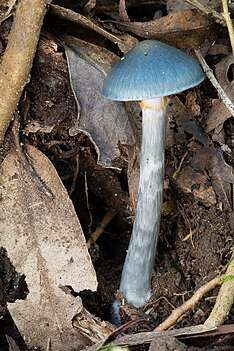Cortinarius rotundisporus
Cortinarius rotundisporus, also known as the elegant blue webcap, is a basidiomycete mushroom of the genus Cortinarius found in southern Australia, where it is found in eucalypt forests and rainforests. The cap of the fruit body is a steely blue colour, with a yellowish boss, and paler similarly coloured stipe.
| Cortinarius rotundisporus | |
|---|---|
 | |
| Scientific classification | |
| Kingdom: | |
| Division: | |
| Class: | |
| Order: | |
| Family: | |
| Genus: | |
| Species: | C. rotundisporus |
| Binomial name | |
| Cortinarius rotundisporus | |
| Cortinarius rotundisporus | |
|---|---|
float | |
| gills on hymenium | |
| cap is convex | |
| hymenium is adnate | |
| stipe is bare | |
| spore print is reddish-brown | |
| ecology is mycorrhizal | |
| edibility: unknown | |
Taxonomy
Cortinarius rotundisporus was initially described by naturalists John Burton Cleland and Edwin Cheel in 1918. It is a member of the subgenus Myxacium within the genus Cortinarius; these species are characterized by the presence of a viscid to glutinous outer veil and stipe. Its specific name is derived from the Latin rotundus "round", and Ancient Greek spora "seed".[1]
Description
The cap ranges from 2.5 to 7 cm (1–3 in) in diameter, and is initially convex before flattening. It has a slight boss that is mustard-, honey- or cream-yellow tinged and steely blue elsewhere. The adnate gills are creamy or lilac-tinged early, and darken with the spores. The slender 5–7.5 cm (2–3 in) stipe lacks a ring; it is pale yellow or white with a tinge of the cap colour. The flesh is yellowish and may have a lilac or pale blue tinge. The spore print is reddish brown and the oval to round spores measure 8.5 × 6.5 µm.[1][2] There is no particular taste or smell. Potassium hydroxide will produce a pink-purple reaction in the stipe or cap.[3] The mycelium is white.[3]
Distribution and habitat
It has been found in New South Wales, Victoria, southeastern South Australia, southern Western Australia, and Tasmania.[1][4] It has also been recorded from New Zealand.[5]
Fruit bodies are found in eucalypt forests and rainforests,[2] and occasionally cleared areas.[6] It forms associations with Eucalyptus, Leptospermum and possibly Casuarina.[5]
See also
References
- Cleland JB (1976) [1935]. Toadstools and mushrooms and other larger fungi of South Australia. South Australian Government Printer. p. 106.
- Fuhrer B. (2005). A Field Guide to Australian Fungi. Bloomings Books. p. 48. ISBN 1-876473-51-7.
- Bougher NL, Syme K (1998). Fungi of Southern Australia. Nedlands, WA: University of Western Australia Press. pp. 256–57. ISBN 1-875560-80-7.
- Cleland, J.B.; Cheel, E. "Cortinarius rotundisporus". Archived from the original on October 6, 2008. Retrieved 2009-02-11.
- Horak E, Wood AE (1990). "Cortinarius Fr. (Agaricales) in Australasia. 1. Subgen. Myxacium and subgen. Paramyxacium" (PDF). Sydowia. 42: 88–168.
- Ratkowsky DA, Gates GM (2005). "An inventory of macrofungi observed in Tasmanian forests over a six-year period" (PDF). Tasforests. 16: 153–68.